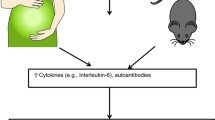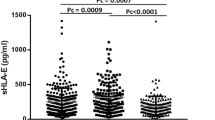Summary
Various diseases with a noticeable autoimmune component and frequent occurrence within one family show a statistically significant correlation with specific human leukocyte antigens (HLA). This correlation was also shown in studies of HLA in psychiatric disorders. However, results have been contradictory.
The phenotype frequencies of HLA specificities were investigated in 100 schizophrenic patients and 472 controls from the same geographic area in Germany. The frequency of HLA B27 was significantly increased in the patient group as a whole (P=0.017) and in the subgroups of paranoid patients (P=0.005), chronic schizophrenics (P<0.001), patients with poor prognosis (P<0.001), and in patients with onset of the disease before the age of 20 years (P=0.004). In the latter three groups an elevated incidence of HLA A9 was also found.
The combination A9-B27 was detected in 0.63% of our control group and in 7% of the patients (P<0.001). Of these patients 85.7% were chronic paranoid patients with poor prognostic features. This study gives support to the possibility of using HLA typing in genetic studies of schizophrenia, as well as in the differential diagnosis and prognosis.
Zusammenfassung
Verschiedene Erkrankungen mit offensichtlicher Beteiligung des Autoimmunesystems und gehäuftem familiärem Vorkommen weisen eine Korrelation mit spezifischen Human Leukocyte Antigens (HLA) auf. Eine solche Korrelation ergab sich auch zwischen HLA und psychiatrischen Erkrankungen. Allerdings sind die bisher gewonnenen Ergebnisse widersprüchlich.
In vorliegender Studie wurden 100 Schizophrene und 472 Kontrollpersonen aus Mannheim auf ihr HLA-Muster untersucht. In der Gesamtgruppe der Schizophrenen fanden wir eine erhöhte Incidenz des HLA B27 (P=0,017). In den Gruppen der paranoiden (P=0,005), der chronisch Schizophrenen (P<0,001) sowie bei Patienten mit ungünstiger Prognose (P<0,001) und Patienten mit Krankheitsbeginn vor dem 20. Lebensjahr fand sich B27 mit erhöhter Incidenz. In den letzteren 3 Gruppen fand sich auch eine erhöhte Incidenz des HLA A9.
Die Kombination A9-B27 wurde in 0,63% der Kontrollgruppe und in 7% des Patientenkollektivs gefunden (P<0,001). 85,7% der Träger dieser Kombination waren chronisch paranoid Kranke mit ungünstiger Prognose.
Diese Studie weist auf die Möglichkeit hin, daß die HLA-Bestimmung für genetische Studien, aber auch zur Differentialdiagnose und zur Prognose der Schizophrenie einmal von Nutzen sein könnte.
Similar content being viewed by others
References
Cazzullo, C. L., Smeraldi, E., Penati, G.: The leukocyte antigenic system HLA as a possible genetic marker of schizophrenia. Br. J. Psychiatry 125, 25–27 (1974)
Crowe, R. R., Thompson, J. S., Flink, R., Weinberger, B.: HLA antigens and schizophrenia. Arch. Gen. Psychiatry 36, 231–233 (1979)
Eberhard, G., Franzén, G., Löw, B.: Schizophrenia susceptibility and HLA antigen. Neuropsychobiology 1, 211–217 (1975)
Feighner, J. P., Robins, E., Guze, S., Woodruff, R. A., Winokur, G., Munoz, R.: Diagnostic criteria for use in psychiatric research. Arch. Gen. Psychiatry 26, 57–63 (1972)
Gattaz, W. F., Beckmann, H.: Das HLA-System in der psychiatrischen Forschung. Fortschr. Neurol. Psychiatr. (in press)
Julien, R. A., Mercier, P., Chouraqui, P.: Schizophrénies et sistème d'histocompatibilité tissulaire; mise en évidence de l'augmentation des antigènes A9 et Cw4 dans la schizophrénie paranoide. Ann. Med. Psychol. 2, 939–944 (1977)
Julien, R. A., Mercier, P., Chouraqui, P., Sutter, J. M.: Schizophrénies et antigènes d'histocompatibilité. L'Encéphale IV, 99–113 (1978)
Österberg, E.: Schizophrenia and rheumatic disease. Acta Psychiatr. Scand. 58, 339–359 (1978)
Robins, E., Guze, S.: Establishment of diagnostic validity in psychiatric illness: its application to schizophrenia. Am. J. Psychiatry 126, 107–111 (1970)
Smeraldi, E., Belodi, L., Cazzullo, C. L.: Further studies on the major histocompatibility complex as a genetic marker for schizophrenia. Biol. Psychiatr. 11, 655–661 (1976)
Spitzer, R. L., Endicott, J., Robins, E.: Research diagnostic criteria. Instrument no. 58, New York State Psychiatric Institute (1975)
Svejgaard, A., Platz, P., Ryder, L. P., Staub-Nielsen, L., Thomsen, M.: HLA and disease association: a survey. Transplant. Rev. 22, 3–43 (1975)
Terasaki, P. I., McClelland, J. D.: Microdroplet assay of human serum cytotoxins. Nature (Lond.) 204, 998–1000 (1964)
Woolf, B.: On estimating the relation between blood group and disease. Ann. Hum. Genet. 19, 251–253 (1955)
Author information
Authors and Affiliations
Rights and permissions
About this article
Cite this article
Gattaz, W.F., Ewald, R.W. & Beckmann, H. The HLA system and schizophrenia. Arch. Psychiat. Nervenkr. 228, 205–211 (1980). https://doi.org/10.1007/BF00342346
Received:
Issue Date:
DOI: https://doi.org/10.1007/BF00342346




